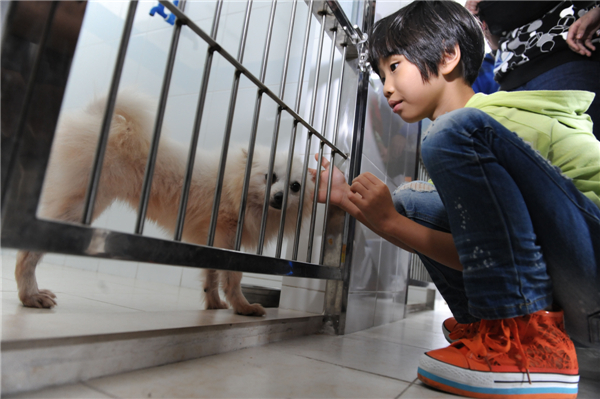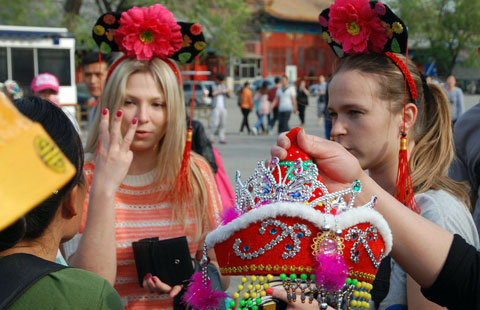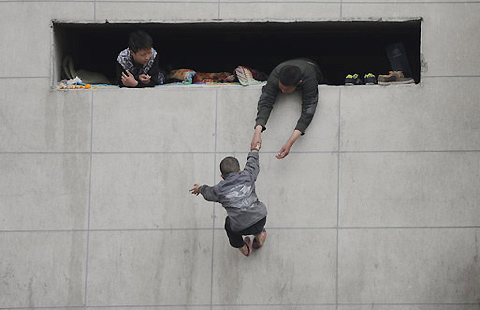Dire situations of small animals cry out for laws
By Zhang Lei ( China Daily ) Updated: 2013-08-27 07:57:58
 |
|
A girl caresses her canine friend at a shelter for stray dogs in Guangzhou, Guangdong province. The shelter is open for residents to adopt pets. QIAN WENPAN / FOR CHINA DAILY |
Millions of cats and dogs slaughtered every year for food and fur trade, Zhang Lei reports
One by one, the joggers passed Dou Bao, a few giving her a quick glance. She is the queen of the campus sports field at the University of International Business and Economics in Beijing. She and the humans swap shifts to rule this territory. The humans control the days, she rules the nights.
Dou Bao, whose name means "Bean Bun", is a cute, brown tabby with a round head and almond-shaped eyes common to Chinese cats. Despite being abandoned, Dou Bao has been lucky. She has found a home on this school campus where the students who named her are welcoming and a number of compassionate souls feed her every day.
However, the harsh reality is that the number of this breed, officially known as the Chinese Li Hua, are dwindling in China every year, primarily because of unchecked interbreeding, but also because foreign breeds are becoming increasingly popular and domestic cats are being pushed aside. Those factors have put a dent in the species, according to Zhang Liyu, head of the Great Wall China Cat Club in Beijing.
The decline comes against a backdrop of a surge in pet numbers in China. There were around 100 million pet dogs and cats in the country at the end of 2012, six times more than a decade ago, according to Dog Fan magazine.
"This is one of the many side effects of the lack of a proper law pertaining to pets. Without that, there's no formal way to deal with the surge in the number of pets. Hundreds of cats and dogs are abandoned every day, especially Chinese breeds. A proper pet law is essential to raising awareness of the conditions in which they live. The matter is of great importance for the Chinese Li Hua, because it's the country's only internationally recognized national breed," said Zhang.
Raising awareness
After spending nine years promoting the breed, the efforts of Zhang and her team were finally rewarded when the Chinese Li Hua was officially accepted by the US Cat Fanciers' Association in February 2010 as an independent breed, not the result of hybridization. Now cats like Dou Bao are registered under the official English name and appear in the miscellaneous class at cat shows.
"This isn't a case of people insisting on pure bloodlines, we simply want Chinese breeds that retain distinct features to be recognized as members of the global cat family. They are as cute as any of the famous foreign breeds," said Zhang. "We hope that by doing so, we can raise public awareness of the living conditions of these Chinese breeds."
Jiang Hong, director of the Southwest China Branch of the China Small Animal Protection Association, said 99 percent of the victims of pet abuse and abandonment are Chinese breeds and the best way to stop uncontrolled breeding and abandonment is to enact specific laws to address the problem.
With the exception of the Law of the People's Republic of China on the Protection of Wildlife, which came into force in 1989, China has no specific laws dedicated to the protection of companion animals. Several existing laws have clauses relating to animal abuse, including the Rabies Management Regulation, under which the transportation of live animals requires transport licenses and disease immunity certificates.
Although this has put a limit on illegal pet animal trafficking to some extent, the past five years have seen an increase in the trafficking of dogs from the rural areas to Beijing. In the days when breeding was unregulated, Pekingese dogs sold for more than 10,000 yuan ($1,633) a decade ago, but now they barely fetch 100 yuan, according to an insider, who spoke on condition of anonymity. He estimated that there are at least 50,000 registered pet dogs in Beijing, but also around 30,000 strays.
In some regions where disease immunity certificates are easy to obtain, some of the trafficking trade caters directly to restaurants where the pets are slaughtered. The insider said 2 million cats and dogs are slaughtered every year for food and for the fur trade, but admitted that his estimate is most likely a conservative one.
In April 2011, volunteers rescued 500 dogs being transported on the Beijing-Harbin highway. The animals were cooped together in poorly made, filthy wire cages. Some had been injured as a result and were taken to pet hospitals. It's believed that the dogs were being taken to a slaughterhouse when they were freed and the truck owner had all the required transport certificates.
During the month that followed, 10 pet hospitals filed lawsuits against the China Small Animal Association, which provided aid in housing the rescued animals, demanding treatment costs of 50,000 yuan.
"This is a gray area, and despite the lax control of certificates in some regions, the fundamental problem is that under the current regulations, pets are treated as private property and there is no legal provision indicating their existence as living species," said Jiang.
To some observers, legislation to protect pets seems like a pipe dream, but in practice, animal rescue at the grass root level is attracting an increasing amount of public attention.
"In the larger cities, the number of animal assistance centers is on the rise and the number of people participating to help these stray animals is growing," Jiang said.
Related Stories:
Animal lovers dote on furry families at fair
- Animal lovers dote on furry families at fair
- Pixar animation expected to make a splash
- Animal lovers dote on furry families at fair
- Vbook: Wild Beijing
- London Zoo conducts annual weigh-in for animals
- About 100,000 visitors attend Chengdu animation and game fair
- Mischievous anime meets fans in China
- Chengdu stores ban bear bile
|
|
|
|
|
|
|
|


















 Op Rana
Op Rana Berlin Fang
Berlin Fang Zhu Yuan
Zhu Yuan Huang Xiangyang
Huang Xiangyang Chen Weihua
Chen Weihua Liu Shinan
Liu Shinan